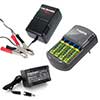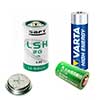Batteries for defibrillators
Published on 06/3/2014
Defibrillators are devices used to transfer voluntarily, and briefly an electric current in the heart when it presents certain problems. The defibrillators are used to save the people of cardiac arrest but they meet standards and obligations.
The regulatory
According to a decree of May 04, 2007 (Decree n ° 2007-705), any person is authorized to use automatic external defibrillators.
The labour regulations does not require companies the obligation to have a defibrillator on their premises. However, the liability of the employer could be held liable in case of accident because he is obliged to ensure the safety of its employees within the company.
The use of a defibrillator
Defibrillation in the first 5 minutes of the accident increases the chances of survival.
If no training is required for the use of a defibrillator, it is still recommended. Appropriate training allows to effectively manipulate the defibrillator and have good reflexes. For example:
- Alert relief by calling the 15 (SAMU) or 112 (emergencies)
- Do not touch the person during the test of heart activity
Choice of location
It is advisable to place the defibrillator in an easy location access and close to places where cardiac events can be the most likely. It is also recommended to protect it from moisture and temperature variations to avoid damaging the battery.
The selected location should be signalled by a poster and the employees must be informed.
Maintenance and maintenance
No text of law requires maintenance of defibrillators in a given period. However, it is strongly recommended to maintain the device regularly, the goal being to be able to use the defibrillator quickly in an emergency.
For more information, it is preferable to refer to the recommendations of the manufacturer.
The battery / battery
The cell or battery is the main source of the unit, usually in 12V power supply.
Food is essential to deliver the shock and also in order to ensure the functioning of the systems of maintenance of the defibrillator in standby mode.
The battery must be replaced periodically. Life expectancy varies between 1 year and 5 years depending on the type, terms of use and the manufacturer.
We recommend that you change the battery a little before the date limit for use.
The new batteries are mostly lithium in order to keep the best performance for 5 years. There is no self-discharge and does not require any maintains individual.
The lithium battery is usually guaranteed 1 year or 12 hours of use or about 180 shocks. Some batteries have intelligent systems of diagnosis of the condition of the battery. An example is the IntelliSense at GE Healthcare System.
Post related products
-

Battery lithium LIFEPAK 1000 PHYSIO-CONTROL 12V 4.5AH for defibrillator LP1000
-

Pack 10 batteries for AED more ZOLL DL123x10
-

Battery Lithium 9145 POWERHEART AED G3 Pro, Cardiac Science 9145-301
-

Battery Lithium 9147 POWERHEART AED Cardiac Science 9147-201
-

Battery Lithium 9143 FIRSTSAVE AED G3 Cardiac Science 9143-101
Express delivery
- By carrier or
- By Postal Service
Professional Quality
Secured Payment
Search in Blog
Par Joël G. (CHALEINS, France métropolitaine) le 10 Jan. 2025 :
Par Olivier I. (PARIS 02, France métropolitaine) le 04 Jan. 2025 :
Par Antoine F. (Etrembières, France métropolitaine) le 01 Jan. 2025 :
















COMMENTS
No customer comments for the moment.